Experimental diets substituted barley for wheat
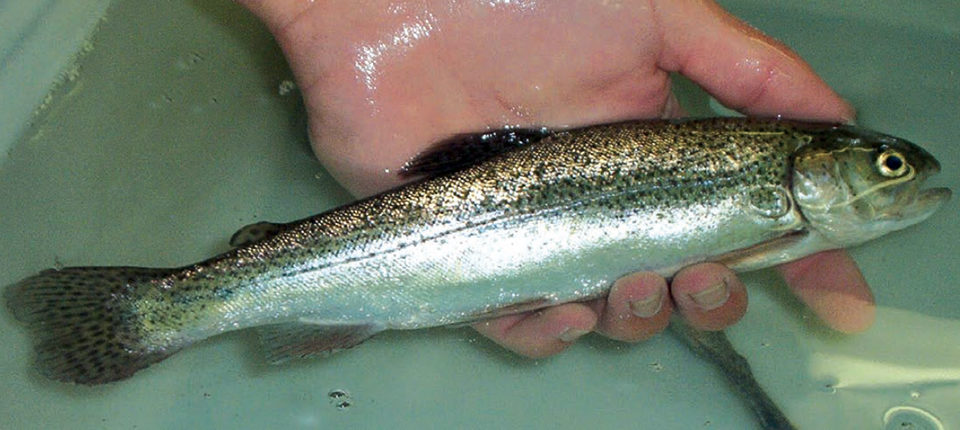
As aquaculture strives to maintain profitability and sustainability in an era of escalating competition for fishmeal and fish oil, plant-based feedstuffs are being incorporated into fish feeds at an increasing rate. Along with the higher inclusion levels and increased variety of plant-based ingredients in these feeds is a pressing need to understand how minor biologically active plant components alter fish growth and health. Also lacking is information regarding how levels of these bioactive components differ between plant sources. This information is necessary to avoid ingredient substitutions that could reduce fish performance.
In the United States, wheat products have been the most utilized carbohydrate source in salmonid diets. In Europe, gelatinized corn starch is now the most widely used starch. Other cereal grains, including barley, also may be suitable feed ingredients for rainbow trout diets.
Barley is a preferred grain for cultivation in many areas of the world due its drought resistance and short growing season. Barley may also have the potential to improve fish health due to high beta-glucan content.
Beta-glucans are structural components of the cell walls of bacteria, fungi, yeasts, and some plants. Beta-glucans from barley, oats, rye, and wheat primarily consist of mixed beta 1,3 and 1,4 linkages at average levels of 1-5 percent. Beta-glucans from fungi and yeast contain beta 1,3 and 1,6 linkages.
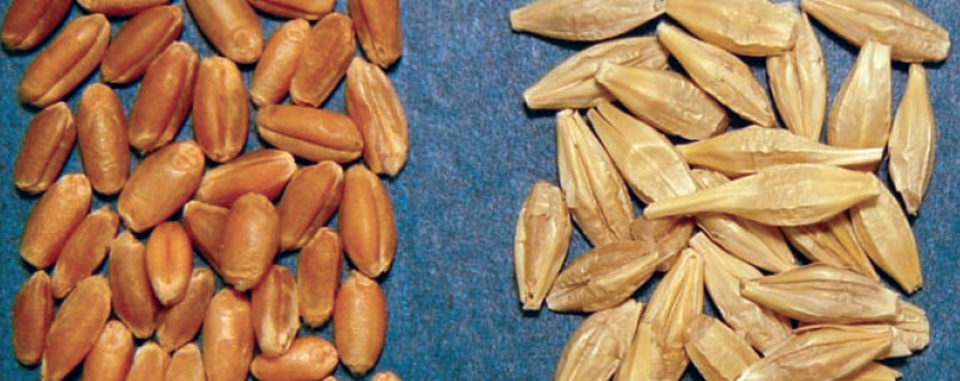
Feeding trial
Because both the source and level of beta-glucans determine their immunostimulatory function, a feeding trial was performed at the University of Idaho Hagerman Fish Culture Experiment Station to screen three barley genotypes containing different levels of beta-glucan for their ability to influence the growth, immune function, and disease resistance of rainbow trout.
Three experimental diets were prepared by substituting barley containing 3.8 percent (low), 5.2 percent (average), and 8.2 percent (high) beta-glucan for the wheat portion of the diet. An additional test diet consisting of the control diet supplemented with a commercially available yeast beta-glucan product at the manufacturer’s recommended level was also evaluated.
Rainbow trout of 14-gram initial weight were reared in 145-liter fiberglass tanks with 50 fish per tank and 3 tanks per diet in a freshwater flow-through system. They were fed the test diets by hand to satiation for nine weeks.
At the conclusion of the trial, fish remaining after sampling were pooled by diet. One subsample was examined for the ability to respond humorally to Infectious Hematopoietic Necrosis Virus (IHNV), and two subsamples were challenged by intraperitoneal injection with IHNV.
Growth
Substituting barley flour for wheat flour in a fishmeal-based diet had significant effects on the growth performance of rainbow trout after three weeks but not after nine (Table 1). At three weeks, fish fed the diet containing the high-beta-glucan barley weighed significantly less than those that received the control diet.
Sealey, Mean growth performance of rainbow trout, Table 1
| Diet | Three- Week Weight Gain (%) | Three- Week Feed- Conversion Ratio | Nine- Week Weight Gain (%) | Nine- Week Feed- Conversion Ratio |
|---|
Diet | Three- Week Weight Gain (%) | Three- Week Feed- Conversion Ratio | Nine- Week Weight Gain (%) | Nine- Week Feed- Conversion Ratio |
|---|---|---|---|---|
| Control | 139a | 0.67c | 532 | 0.90 |
| 3.8% beta-glucan | 137ab | 0.70bc | 524 | 0.95 |
| 5.2% beta-glucan | 143a | 0.73ab | 554 | 0.95 |
| 8.2% beta-glucan | 115b | 0.77a | 547 | 0.98 |
| Yeast | 137ab | 0.75a | 512 | 0.97 |
| Pooled S.E. | 4.91 | 0.01 | 22.04 | 0.02 |
Values within columns with common superscript letters do not differ significantly (P 0.05).
Feed conversion was higher in groups fed the high-beta-glucan barley or the commercially available yeast beta-glucan diets compared to fish fed the wheat control diet or the low-beta-glucan barley diets. After nine weeks, no significant differences among dietary treatments were observed for growth or feed conversion.
Disease resistance
Fish fed diets containing the average- or high-beta-glucan barley genotypes survived an IHNV challenge similarly to those fed the commercial diet and better than those fed the wheat control diet (Fig. 1).
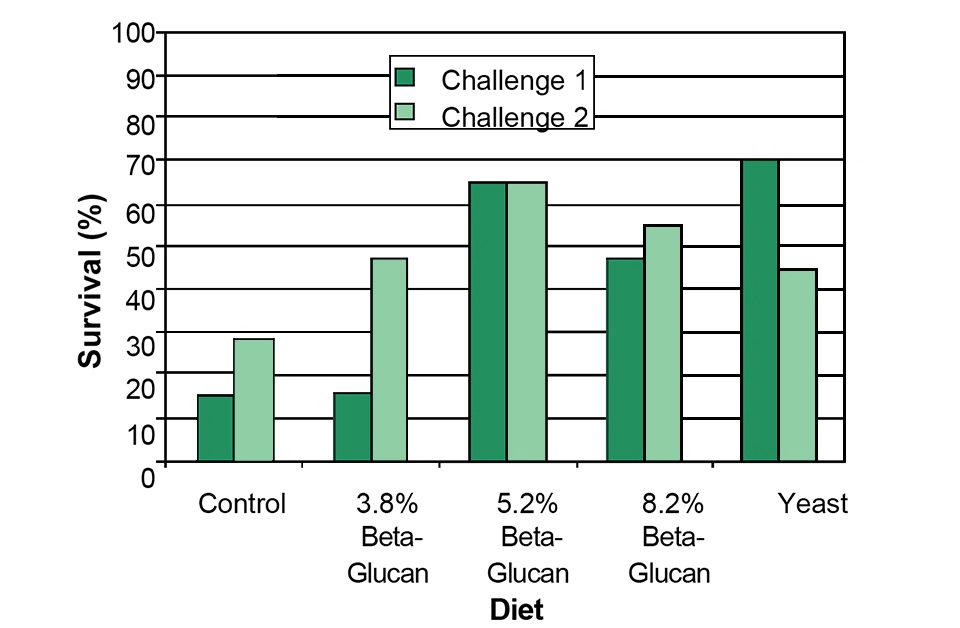
Numerous studies have addressed the immunostimulating potential of beta-glucan in fish. Branched-chain beta 1,3 beta 1,6-linked glucans found in yeast have been the primary focus of research in fish, although some studies indicate that the more linear beta 1,3 beta 1,4-linked glucans isolated from barley are effective immunostimulants. Data from the current study further supports the ability of barley beta-glucan to stimulate fish immune responses.
Researchers have previously reported that feeding 0.1 to 0.2 percent dietary glucan for one to four weeks enhances immune response and disease resistance in rainbow trout, while higher levels and feeding for longer periods have detrimental effects.
In the current study, a barley beta-glucan content of approximately three times the recommended levels produced positive effects on disease resistance. Higher efficacious dosage requirements have also been reported when utilizing beta 1,3 beta 1,4-linked glucans. However, in contrast to previous reports, feeding rainbow trout high levels of barley glucans for periods longer than the recommended one to four weeks had no detrimental effect on immune responses and disease resistance.
Future research
To date, few studies have accounted for endogenous levels of beta-glucans in plant-based aquatic animal feedstuffs. This oversight is due in part to the fact that analytical methodologies for the quantification of bioactive compounds like beta-glucans are only now becoming widely available, and in part to the contention that the immunostimulation potential of beta-glucans present in most feedstuffs would be minimal because these endogenous glucans are unable to freely bind glucan receptors and thus activate intestinal macrophages.
Although the underlying immunostimulatory mechanisms remain undefined, the current study provides supporting evidence that beta-glucans in barley can increase disease resistance in rainbow trout. The identification of additional cereal grains suitable for utilization in fish feeds offers potential for more flexible and possibly more economical formulations for feed manufacturers and new markets for grain producers.
(Editor’s Note: This article was originally published in the May/June 2007 print edition of the Global Aquaculture Advocate.)
Now that you've reached the end of the article ...
… please consider supporting GSA’s mission to advance responsible seafood practices through education, advocacy and third-party assurances. The Advocate aims to document the evolution of responsible seafood practices and share the expansive knowledge of our vast network of contributors.
By becoming a Global Seafood Alliance member, you’re ensuring that all of the pre-competitive work we do through member benefits, resources and events can continue. Individual membership costs just $50 a year.
Not a GSA member? Join us.
Authors
-
Wendy M. Sealey, Ph.D.
University of Idaho
Hagerman Fish Culture Experiment Station
3059F National Fish Hatchery Road
Hagerman, Idaho 83332 USA -
Ronald W. Hardy, Ph.D.
University of Idaho
Hagerman Fish Culture Experiment Station
3059F National Fish Hatchery Road
Hagerman, Idaho 83332 USA -
Frederic T. Barrows, Ph.D.
United States Department of Agriculture
Agricultural Research Service
Hagerman Fish Culture Experiment Station
Hagerman, Idaho, USA -
Katherine A. Johansen, Ph.D.
United States Department of Agriculture
Agricultural Research Service
Hagerman Fish Culture Experiment Station
Hagerman, Idaho, USA -
Kenneth Overturf, Ph.D.
United States Department of Agriculture
Agricultural Research Service
Hagerman Fish Culture Experiment Station
Hagerman, Idaho, USA -
An Hang, Ph.D.
United States Department of Agriculture
Agricultural Research Service
National Small Grains and Potato Germplasm Research Facility
Aberdeen, Idaho, USA -
Scott E. LaPatra, Ph.D.
Clear Springs Foods, Inc.
Research Division
Buhl, Idaho, USA
Tagged With
Related Posts
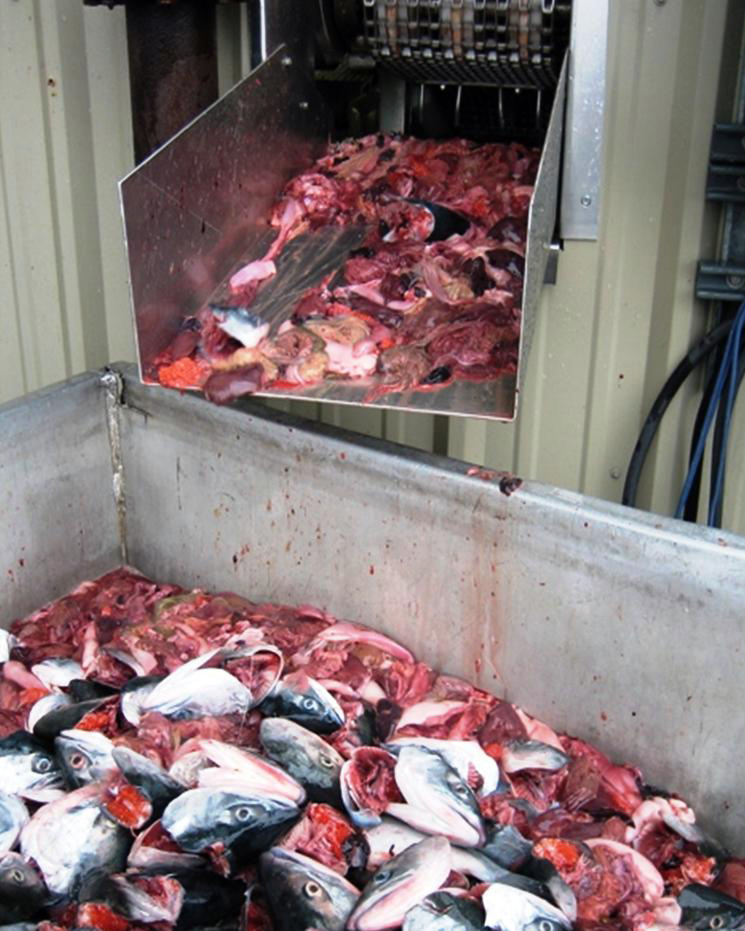
Aquafeeds
U.S. agencies focus on fishmeal in feed
The National Oceanic and Atmospheric Administration and U.S. Department of Agriculture joined forces through the NOAA-USDA Alternative Feeds Initiative to identify feed ingredients that will reduce the amount of fishmeal and fish oil in aquaculture feeds while maintaining the human health benefits of seafood. Through research on a variety of sources, promising alternatives are beginning to emerge.

Responsibility
Understanding water quality variables for aquaculture
Confusion can result because of differences in units (dimensions) used to report water quality variables, which can lead to faulty assessments. Professor Claude Boyd discusses issues related to units of measure for some common water quality values in aquaculture.
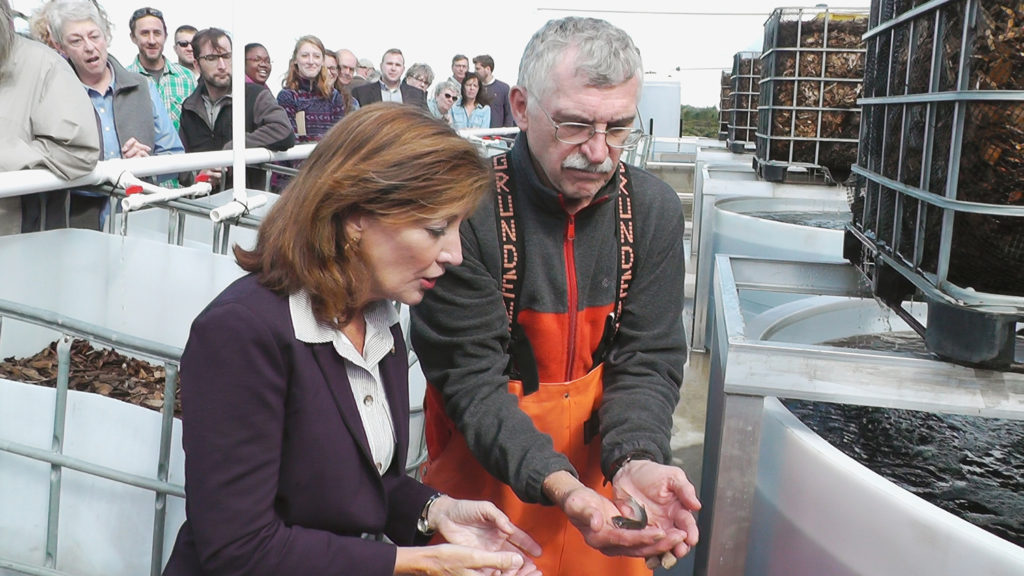
Innovation & Investment
When Perch Met Pale Ale: A nothing-goes-to-waste love story
A unique joint venture is bringing a land-based recirculating aquaculture system to a farming community near Lake Erie. It’s a wastewater treatment program that aims to provide a sustainable food source for the local community.
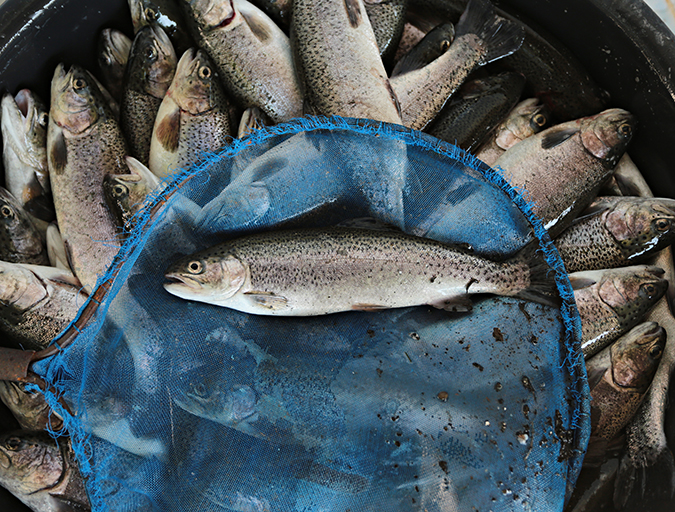
Intelligence
We’re no longer nomads, so we should farm more fish
As terrestrial protein production is confined by limited available and suitable land, aquaculture is the logical solution to our nutritional needs. We can get serious about it or we can let our grandchildren grow up in a world eerily similar to that of their ancestors.



